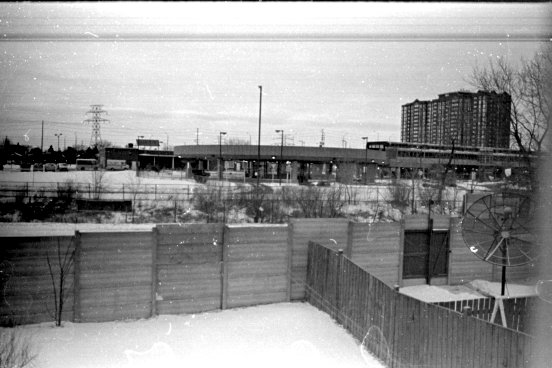Cafétype Photography

I'm not sure how I found the link to Scott Williams's paper on processing film with coffee, but I knew straight away I had to try it. As a dedicated coffee drinker, I knew it was my duty.
This image is the unretouched result. With better handling, I could have scratched it and blotched it less, but to have an image at all is pretty startling.
I bought the cheapest film I could find (Agfa APX-400; about C$2.25 for 20 exposures), and a really cheap AP-brand tank, for I didn't want the coffee to stain my existing tanks. (The AP tank's really easy to load, and I almost prefer it to my Paterson Universal tanks).
The most important ingredient came next — the coffee itself. I chose a really cheap espresso grind (Montini, about C$2.50 for 250g). It's actually not a bad drinking coffee, but not once you prepare it as a developer.
Taking the Pictures
I shot a test roll at EI 100 with my Bessa-R/35mm f/1.7 combo. I bracketed -2/-1/0/+1/+2 stops so I could cover an EI range of 25-400. As it turns out, I got the best results at about EI 200. Further experimentation is needed.
Brewing the Developer
I put 4 rounded tablespoons of coffee into a cafetière (french press, or Bodum) and added approximately 800ml of boiling water. I let it steep for 9 minutes, and then pushed the filter down.
I decanted 400ml of the coffee into another container and added 4 rounded teaspoons of bicarbonate of soda. This amount was a guess, but I knew I had to kill the acidity of the coffee.
Other Chemistry
I could have used plain water as a stop bath, but I ended up using extremely dilute Ilford Indicator Stop bath so I could tell that the yellow solution was the stop, and not the fixer. I used this stop bath one-shot, as I don't want fine coffee solids on my other negatives.
The fixer was Agfa Agefix at the recommended dilution and time. Again this was used and discarded, as coffee grounds don't make sharp negatives.
Development
I let the tank and all the solutions warm up to 34°C in a water bath, then I poured the coffee into the tank. I agitated the tank about once a minute for 25′30″. When I poured the developer out, its temperature was 31°C.

Once stopped, fixed and washed, the negatives are very thin, with strong staining of the base material (not to mention a good reek of stale coffee). To show you how faint the negatives are, a picture from my lightbox is shown here. The upper image is a regular negative (PanF+/Ilfotec DD-X), the lower one a cafétype. Despite the staining, these seem to scan quite well. Their limited dynamic range is well within that of my flatbed scanner.

The above strip shows that there is a noticeable effect at each stop of under and over exposure.
Future Directions
I'll keep refining the formula and development process. I'd really like to find a more 'household' replacement for the fixer, but I guess there aren't many household products that contain ammonium or sodium thiosulphate.
Links
- "A Use for that Last Cup of Coffee: Film and Paper Development", <https://people.rit.edu/andpph/text-coffee.html>: Dr. Scott Williams, Rochester Institute of Technology.
- Photo.net online discussion (with examples): <http://www.photo.net/bboard/q-and-a-fetch-msg?msg_id=003aPB>
Updates
20 Feb 02003 Trying a room-temperature solution was not successful, even after extending development to an hour. Images are there, but extremely faint. This could also be due to me using half the amount of baking soda as before …
2 Mar 02003 Trying really hot coffee for a shorter
period (5 minutes) didn't work. It seemed to put the base fog way up,
with almost invisible images in the almost cooked-off emulsion. I
think that Scott Williams's technique might be about as good as it's
going to get.
(One thing I learned: don't dump a load of
bicarbonate solution into a hot pot of coffee unless you like cleaning
up the resulting brown geyser. This has been a public sanity
announcement.)
5 Apr 02017 A reader advised that, after 14 years, the Williams article has moved fractionally. URL updated!